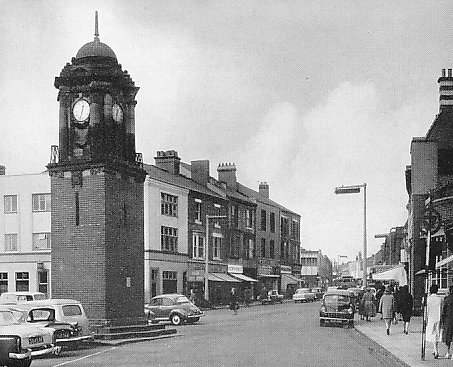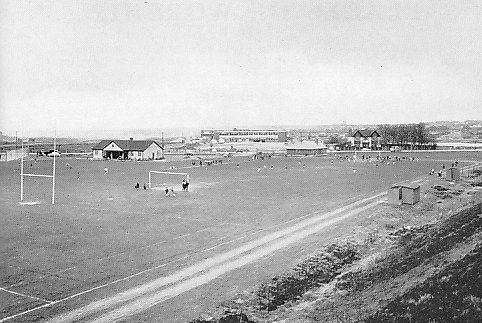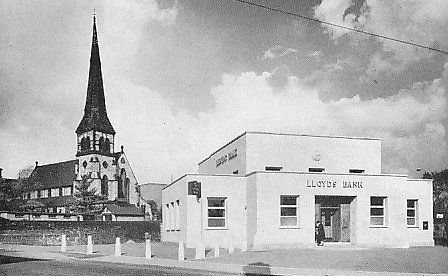|
There were books to be borrowed
from the public library in Walsall Street, or from the
mobile library, which served the outlying parts of the
borough.
At the time, the library had a
separate children’s section, a reference library, a
gramophone record library, and a reading room with a
wide range of newspapers and periodicals. |

The Public Library. |
|
The two public parks, Brunswick
Park, and King’s Hill Park were well used. A major event
in Brunswick Park was the Horticultural Show, held
annually by the Wednesbury Horticultural Society. At the
time a large central mound in Brunswick Park was being
removed to form an arena, which was to be used for all
kinds of events. During the summer, band concerts were
given, and the children’s paddling pool was well used,
as were the tennis courts and bowling green. There were
also ornamental gardens at Ethelfleda Terrace, near the
Parish Church, which had opened in 1953.
The under 20s were well catered for
by 17 youth clubs, and boy scouts, and girl guides
associations. There were three cinemas, the Gaumont in Walsall Street, the Palace in Upper High
Street, and the Rialto in Earps Lane. Wednesbury
Hippodrome in Upper High Street had recently reopened
with a series of plays performed by the resident
repertory company.
There was also the community centre in
Friar Park Road, run by the Friar Park Community
Association, and the Civil Defence Corps based at Manor
House Road Training Centre. |
|

The Market Place. |
There were a number of clubs in the town including
the Conservative and Unionist Club in Walsall Street,
the Labour Club at Church Hill, and the Rotary Club,
based at the Anchor Hotel in Holyhead Road. The local
branch of the British Legion met at a newly erected
headquarters in Church Street, the Old Age Pensioners’
Association met in the Town Hall, and the Sons of Rest,
based in Foley Street, was provided for retired men.
The Wednesbury Society of Arts, based in the Art
Gallery, had four sections, the Civic Choir, the
Photographic Society, the Recorded Music Society, and
the Art Club. There was also a drama group, and the
Wednesbury and District Choral Society, founded in 1898. |
|
Sport
The Wednesbury Sports Union,
established in 1936, coordinated the activities of the
towns’ cricket, hockey, rugby, swimming, and tennis
clubs, from its headquarters off Wood Green Road. The
Union’s sports field was originally a plot of land owned
by the Patent Shaft and Axletree Company, and given to
the town in 1868 for use as a cricket ground. In 1875 it
became the home of the Wednesbury Cricket Club. In 1953 a new car park opened on Wood Green
Road, and a new pavilion opened in the early 1960s.
There were ladies’ and gentlemen’s
tennis and hockey clubs, a badminton club, and a boxing
club. The two latter clubs played at the public baths in Walsall
Street. |
|
The swimming club was a member of
the Birmingham and District Water Polo League, which had
been founded in 1895.
Football was extremely popular in
the town. The Wednesbury Football Charity Association
provided three trophies for annual competitions between
local clubs, and schools.
They were the Senior Cup, the
Junior Charity Cup, and the Schools Charity Shield. Many
local clubs competed in the Wednesbury and District
Football League. |

Hydes Road Playing Fields. |
|
Cycling was well catered for by the
Wednesbury Velo Cub, which was affiliated to the British
League of Racing Cyclists. It was formed in the 1940s by
fans of the late Wolverhampton cyclist Percy Stallard.
The club had a rule book, which had to be strictly
adhered to. Anyone disobeying a rule would receive a
fine.
Several of the larger companies had
football teams, athletics clubs, and social clubs, and
there were several bowling clubs and greens in the town.
By the late 1950s the Borough
Council had reclaimed nearly 40 acres of derelict land
near Hydes Road for use as playing fields. The project
started in 1939 thanks to some financial assistance from
the National Playing Fields Association. At the time
there were 4 association football pitches, a rugby
pitch, 2 cricket grounds, a children’s playground, a
well appointed pavilion with facilities for players and
spectators, and a bungalow for the groundsman. Work had
begun on preparing land for 2 tennis courts. Around 68
trees had been planted around the perimeter of the
playing fields thanks to donations from local schools.
There were other playing fields at Bilston Road, and
Woden Road North.
Places of Worship
Church-goers were well catered-for
in the town. There was the parish church of St.
Bartholomew, and ecclesiastical parishes based at St.
John’s Church, St. James’ Church, and All Saints Church
at Moxley. There was also St. Paul’s Church in Wood
Green, St. Andrew’s Mission Church at King’s Hill, and
St. Luke’s Mission Church in Mesty Croft. |
|

St. John's Church, and the newly
built Lloyds Bank. |
Catholic worshipers could attend St. Mary’s Roman
Catholic Church on Church Hill, and Methodists could
attend Spring Head Mission Church, and churches in
Ridding Lane, Elwell Street, Vicar Street, and King’s
Hill. Baptists could attend the Baptist Church in
Holyhead Road, and Salvationists could attend the
Salvation Army barracks in Upper High Street, and
Crankhall Lane. |
| There was much to see and do. There were many pubs,
and several restaurants, including the Wadsworth
Restaurant, the Central Café in Lower High Street,
and The Anchor Hotel in Holyhead Road. |
 |
|
 |
|
 |
Return to the
council and transport |
|
Return to
the contents |
|
Proceed to
Education |
|